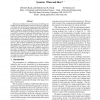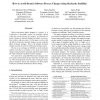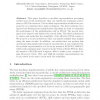26354 search results - page 175 / 5271 » How we refactor, and how we know it |
CHI
2009
ACM
14 years 3 months ago
2009
ACM
The use of examples serves a critical role in creative design practice, but details of this process remain an enigma. This is problematic for both the understanding of design acti...
IPPS
1996
IEEE
14 years 2 months ago
1996
IEEE
Advances in multiprocessor interconnect technologyare leading to high performance networks. However, software overheadsassociated with message passing are limiting the processors ...
ICSE
2009
IEEE-ACM
14 years 5 months ago
2009
IEEE-ACM
Before performing drastic changes to a project, it is worthwhile to thoroughly explore the available options within the current structure of a project. An alternative to drastic c...
CHES
2007
Springer
14 years 5 months ago
2007
Springer
This paper describes a modular exponentiation processing method and circuit architecture that can exhibit the maximum performance of FPGA resources. The modular exponentiation arch...
RV
2007
Springer
14 years 4 months ago
2007
Springer
When monitoring a system wrt. a property defined in some temporal logic, e. g., LTL, a major concern is to settle with an adequate interpretation of observable system events; that...




